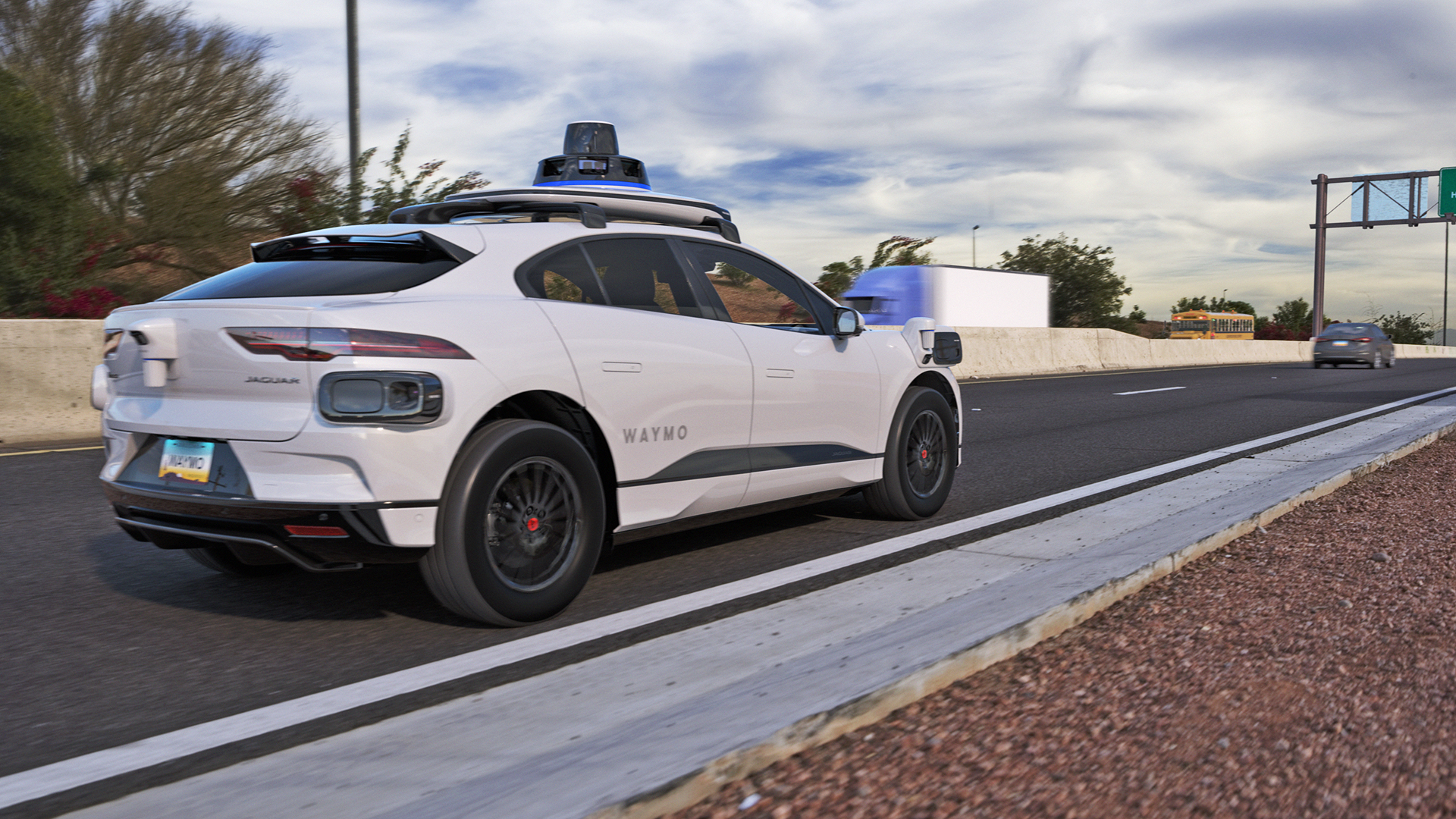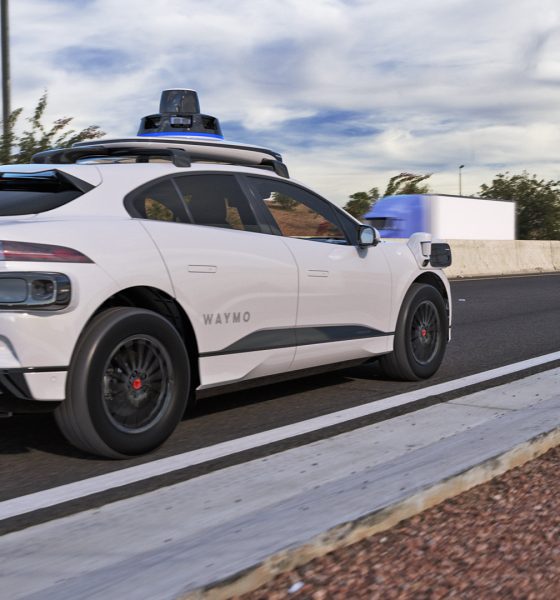Waymo, the self-driving unit from Google parent company Alphabet, is set to expand its autonomous vehicle testing to include select freeways in Arizona.
In a press release on Monday, Waymo announced the plans to begin testing its rider-only ride-hailing trips on freeways across Phoenix, in a phased approach that will start with trips for employees. While the release didn’t state a specific date that these tests will begin, the company says it has been incrementally ramping up its driver-monitored testing on freeways over the last year.
“Waymo will begin testing its fully autonomous passenger cars without a human driver on freeways in Phoenix to soon help Waymo One riders get where they’re going safely and efficiently,” writes the company in the release.
Waymo says that it also has years of testing experience with rider-only vehicle fleets, set to help inform its safety approach to the expansion. In addition, Waymo shared a video of its self-driving system navigating freeways for both a passenger vehicle and a class 8 truck, both of which the company says it has millions of miles of experience testing with a specialist present.
You can see footage from the Waymo video below, in which the system is navigating both a passenger vehicle and a class 8 truck.
Waymo also notes the significant time savings that expanding to freeway routes will offer. This is evidenced in side-by-side images shared in the release of a drive from the Sky Harbor International Airport to Northern Scottsdale, with and without freeways, the former of which cuts the driving time in half.
Credit: Waymo
The autonomous ride-hailing company also says it plans to work closely with public safety officials on best practices, along with teaching them about Waymo’s technology. Waymo also detailed its safety approach in a 2020 blog post, which can be found here.
On its website, the Arizona Department of Transportation (ADOT) outlines the state’s autonomous driving program and lists companies that have submitted to test and operate autonomous vehicles in the state, including Waymo.
“Public safety is our highest priority, and we are in regular communication with and closely monitoring autonomous vehicle companies testing and operating self-driving vehicles in Arizona,” wrote Bill Lamoreaux, ADOT Motor Vehicle Department Assistant Comms Director, in an email to Teslarati.
Lamoreaux also noted that Waymo and other companies must follow all federal traffic laws, regulations and guidelines, as well as Title 28 of the Arizona Revised Statutes and all regulations and policies set forth by ADOT.
Operations from Waymo and other autonomous ride-hailing companies such as Cruise have been scrutinized by regulators in the past. Although Cruise’s state permit to operate driverless vehicles was revoked in California following an accident with a pedestrian, Waymo is still approved to test its vehicles in San Francisco.
Despite the potential safety risks presented by self-driving vehicles, the systems are also expected to improve as they are tested more and more, with the ultimate goal of helping them someday become safer than human drivers.
Tesla is another company testing an early, semi-autonomous driving system with its Full Self-Driving (FSD) beta, which can be operated by users who purchase the add-on. Although Tesla’s FSD beta model doesn’t include ride-hailing, nor does it include fully driverless operations, the company has long touted a future of “robotaxis,” and highway testing has been available on the beta software for years.
Updated 2:44 p.m. MT: Added response from the Arizona Department of Transportation.
What are your thoughts? Let me know at zach@teslarati.com, find me on X at @zacharyvisconti, or send your tips to us at tips@teslarati.com.

Elon Musk
Elon Musk and Tesla AI Director share insights after empty driver seat Robotaxi rides
The executives’ unoccupied tests hint at the rapid progress of Tesla’s unsupervised Robotaxi efforts.

Tesla CEO Elon Musk and AI Director Ashok Elluswamy celebrated Christmas Eve by sharing personal experiences with Robotaxi vehicles that had no safety monitor or occupant in the driver’s seat. Musk described the system’s “perfect driving” around Austin, while Elluswamy posted video from the back seat, calling it “an amazing experience.”
The executives’ unoccupied tests hint at the rapid progress of Tesla’s unsupervised Robotaxi efforts.
Elon and Ashok’s firsthand Robotaxi insights
Prior to Musk and the Tesla AI Director’s posts, sightings of unmanned Teslas navigating public roads were widely shared on social media. One such vehicle was spotted in Austin, Texas, which Elon Musk acknowleged by stating that “Testing is underway with no occupants in the car.”
Based on his Christmas Eve post, Musk seemed to have tested an unmanned Tesla himself. “A Tesla with no safety monitor in the car and me sitting in the passenger seat took me all around Austin on Sunday with perfect driving,” Musk wrote in his post.
Elluswamy responded with a 2-minute video showing himself in the rear of an unmanned Tesla. The video featured the vehicle’s empty front seats, as well as its smooth handling through real-world traffic. He captioned his video with the words, “It’s an amazing experience!”
Towards Unsupervised operations
During an xAI Hackathon earlier this month, Elon Musk mentioned that Tesla owed be removing Safety Monitors from its Robotaxis in Austin in just three weeks. “Unsupervised is pretty much solved at this point. So there will be Tesla Robotaxis operating in Austin with no one in them. Not even anyone in the passenger seat in about three weeks,” he said. Musk echoed similar estimates at the 2025 Annual Shareholder Meeting and the Q3 2025 earnings call.
Considering the insights that were posted Musk and Elluswamy, it does appear that Tesla is working hard towards operating its Robotaxis with no safety monitors. This is quite impressive considering that the service was launched just earlier this year.
Elon Musk
Starlink passes 9 million active customers just weeks after hitting 8 million
The milestone highlights the accelerating growth of Starlink, which has now been adding over 20,000 new users per day.

SpaceX’s Starlink satellite internet service has continued its rapid global expansion, surpassing 9 million active customers just weeks after crossing the 8 million mark.
The milestone highlights the accelerating growth of Starlink, which has now been adding over 20,000 new users per day.
9 million customers
In a post on X, SpaceX stated that Starlink now serves over 9 million active users across 155 countries, territories, and markets. The company reached 8 million customers in early November, meaning it added roughly 1 million subscribers in under seven weeks, or about 21,275 new users on average per day.
“Starlink is connecting more than 9M active customers with high-speed internet across 155 countries, territories, and many other markets,” Starlink wrote in a post on its official X account. SpaceX President Gwynne Shotwell also celebrated the milestone on X. “A huge thank you to all of our customers and congrats to the Starlink team for such an incredible product,” she wrote.
That growth rate reflects both rising demand for broadband in underserved regions and Starlink’s expanding satellite constellation, which now includes more than 9,000 low-Earth-orbit satellites designed to deliver high-speed, low-latency internet worldwide.
Starlink’s momentum
Starlink’s momentum has been building up. SpaceX reported 4.6 million Starlink customers in December 2024, followed by 7 million by August 2025, and 8 million customers in November. Independent data also suggests Starlink usage is rising sharply, with Cloudflare reporting that global web traffic from Starlink users more than doubled in 2025, as noted in an Insider report.
Starlink’s momentum is increasingly tied to SpaceX’s broader financial outlook. Elon Musk has said the satellite network is “by far” the company’s largest revenue driver, and reports suggest SpaceX may be positioning itself for an initial public offering as soon as next year, with valuations estimated as high as $1.5 trillion. Musk has also suggested in the past that Starlink could have its own IPO in the future.
News
NVIDIA Director of Robotics: Tesla FSD v14 is the first AI to pass the “Physical Turing Test”
After testing FSD v14, Fan stated that his experience with FSD felt magical at first, but it soon started to feel like a routine.

NVIDIA Director of Robotics Jim Fan has praised Tesla’s Full Self-Driving (Supervised) v14 as the first AI to pass what he described as a “Physical Turing Test.”
After testing FSD v14, Fan stated that his experience with FSD felt magical at first, but it soon started to feel like a routine. And just like smartphones today, removing it now would “actively hurt.”
Jim Fan’s hands-on FSD v14 impressions
Fan, a leading researcher in embodied AI who is currently solving Physical AI at NVIDIA and spearheading the company’s Project GR00T initiative, noted that he actually was late to the Tesla game. He was, however, one of the first to try out FSD v14.
“I was very late to own a Tesla but among the earliest to try out FSD v14. It’s perhaps the first time I experience an AI that passes the Physical Turing Test: after a long day at work, you press a button, lay back, and couldn’t tell if a neural net or a human drove you home,” Fan wrote in a post on X.
Fan added: “Despite knowing exactly how robot learning works, I still find it magical watching the steering wheel turn by itself. First it feels surreal, next it becomes routine. Then, like the smartphone, taking it away actively hurts. This is how humanity gets rewired and glued to god-like technologies.”
The Physical Turing Test
The original Turing Test was conceived by Alan Turing in 1950, and it was aimed at determining if a machine could exhibit behavior that is equivalent to or indistinguishable from a human. By focusing on text-based conversations, the original Turing Test set a high bar for natural language processing and machine learning.
This test has been passed by today’s large language models. However, the capability to converse in a humanlike manner is a completely different challenge from performing real-world problem-solving or physical interactions. Thus, Fan introduced the Physical Turing Test, which challenges AI systems to demonstrate intelligence through physical actions.
Based on Fan’s comments, Tesla has demonstrated these intelligent physical actions with FSD v14. Elon Musk agreed with the NVIDIA executive, stating in a post on X that with FSD v14, “you can sense the sentience maturing.” Musk also praised Tesla AI, calling it the best “real-world AI” today.










